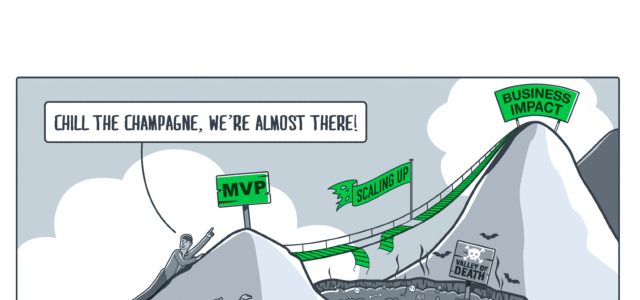I’ve written many times that although there is only one cause of transformation failure – and that is lack of focus – this presents as any number of “reasons” commonly given for the 70-90% of projects that do crash and burn.
Nothing illustrates this lack of focus better than our very use of the term “digital transformation”, which, I believe, encourages a common misunderstanding of what “transformation” really is and prompts many organisations to head in the wrong direction.
So, let’s get a few things straight about the digital transformation bandwagon so many organisations are jumping onto.
Transformation #101
Transformation is nothing new. It’s been happening since the beginning of time and relates to every area of our lives. Fundamentally it just the process of adjusting our lives to accommodate shifting circumstances. These can be social or climate changes for example, but mostly it’s to do with the advance of technology.
The wheel, electricity, Henry Ford’s production line and the invention of the computer or mobile phone have all influenced the way we live and work. Generally, each of these technological step-changes has been greater than its predecessors … and then there was digital.
The advent of digital technology is by far the biggest incremental change we’ve ever encountered. It affects every area of our lives and its influence has been monumental. Nevertheless, despite its significance, digital technology remains only an enabler to change. It’s not change itself and that’s where many people go wrong.
Putting “digital transformation” in context
Digital technology enables us to do things most of us have only ever dreamt of. It’s labour-saving in the extreme, it’s accurate, reliable and increasingly fast. In fact, you can achieve in seconds things that in the past would have taken thousands of people years to do.
This enables us to gather information, analyse it, develop responses, design and make things, talk to people and much more without human intervention. It also means that companies with a headcount of two or three can beat a global corporation at their own game.
The bottom line of all this is that we now have the potential to eliminate compromise and deliver tailored products and solutions to individual users and that’s an opportunity no business can afford to miss.
Digital isn’t the point
A digital business can deliver a better solution to a customer’s needs, faster, more cheaply and infinitely more efficiently than a traditional business ever could and that means traditional businesses simply can’t compete.
However, although a business in the digital age is definitely enabled by digital technology, it doesn’t mean that everything has to be on-line and the degree of digital intervention will vary in different areas of an organisation. In fact, some of the most successful disrupters of recent times are a combination of old and new processes and tools uniquely combined and driven by digital technology.
Many of the conversations I have with organisations and their leaders start with a request for “digital transformation”. This is where they leap on board the digital transformation bandwagon and where, for many, the trouble starts. Almost without exception, a few minutes of talk with them is enough to reveal their understanding of the term “transformation” is inaccurate or at best far too narrow.
I start to address this by trying to wean people off the “digital” terminology and get them to focus on the real issue. Sure, to compete in the new economy a business has to embrace digital technology, but it’s a big mistake to start your transformation by building a digital infrastructure.
This is the equivalent of creating a machine and then working out what you can make with it. It’s a classic example of the inherent disadvantage of traditional businesses that have, to date, delivered solutions compromised by the businesses available resources.
In the digital economy, where competitors have the capability to deliver an exact match to customer needs it’s simply not good enough. The very point of transformation is to get away from that and, as thousands of failed transformation projects testify, if you approach your transformation as a “digital” project you’ll mostly not get the outcome you are looking for.
Transformation starts with an objective
The starting point to any transformation should be to identify your objective. I have a process for achieving this that follows the basic principles of marketing real marketers have applied for generations.
At it’s most basic this is a seven-step process requiring you to consider the following:
- consumer needs
- the capability of your competitors to deliver these needs
- identification of the gaps in their combined offering
- assessment of your organisation’s resources
- identification of solutions you are best able to deliver
- assessment of the gaps you must fill in your own resources to be able to do this efficiently
- strategy for re-engineering your organisation
This places your objective front and centre, provides you with the framework for building your brand, which in turn brings you to transformation ground zero. Then you can start re-engineering your business using digital components where they are available or appropriate.
It sounds obvious, but very few businesses do this. Instead they dive into building digital infrastructure that usually at best streamlines their old business model. This may result in short-term gain, but in reality it only accelerates the organisation’s demise, because the issue isn’t the machinery of the business, but how it is used and what it is used to produce.
Digital isn’t exclusive
The disrupters that are causing traditional businesses so much grief right now are successful because they were created in the context of today’s capability and are a response to the question “what do consumers really want?”. Much of the technology they use is digital, but that’s only because today’s tech is digital. Yet, that’s by no means the sum of it.
We should also be careful not to throw the baby out with the bathwater. Traditional businesses have a legacy. Some aspects of it, like a customer base, knowledge and experience may be good to have, even though others, especially culture and methodology aren’t always a good thing. That’s why there’s much talk of business transformation in the digital age as “culture change”. But it’s not even that simple.
Digital technology hasn’t just enabled businesses to be more efficient – achieve more with less – it’s changed how consumers think too. Mostly it’s made them more slippery, harder to pin down because they keep changing their priorities, and that happens because influences are far more fluid.
This matters less to a digitally enabled business because technology also provides us with the wherewithal to understand the new consumer. Digital businesses are sensitive to these changes and those that invest heavily enough on technology can even predict them.
In fact, maybe the biggest change a transformed-business experiences, is increased fluidity. Traditional businesses are used to making a plan and sticking to it. A digital business may have a plan too, but that plan is not to be tied to a plan. To succeed in the digital economy you simply can’t afford to be inflexible.
The shifting role of business leaders
This raises the need for different working practices and different forms of leadership. Professor Ronald Heifetz refers to effective managers in the digital age as “adaptive managers”. These are leaders who, while they have their eyes on the objective will continually adapt their course to take advantages of emerging opportunities and threats. And these arise on a daily, even hourly basis.
Working with a “sketchy” plan like this doesn’t sit well with traditional managers, but they have to learn to adapt if they are to remain relevant. Another of those many reasons for failure I mentioned earlier is that business leaders fear they won’t be able to adapt and therefore resist change in the hope they can maintain the status quo. Of course, that doesn’t work.
Transformation marks a transition from a state of order that you may have become comfortable with, to, a very uncomfortable for some, state of constant change, which is partly why so many leaders find it difficult.
However, traditional leaders are by no means redundant in the digital age. Think back to a moment ago when I mentioned the value of positive legacy within their transformed model. The same applies to leadership. There is much that an experienced leader can bring to the digital party and it’s important that these assets aren’t lost to a business because it’s leaders fail to adapt their approach.
In the digital economy, successful leaders above all have to be facilitators. Because innovation, which is another essential component of a digital business, is dependent on diversity, our leaders also have to abandon the command and control management model that may have brought them success in the past.
Digital technology may be the essential ingredient in any contemporary business model, but traditional business leaders, by definition, will simply be too old to even hope to relate to technology as a digital native does.
And that’s fine, because digital instincts abound in any business. You just have to look for them. Today’s leaders will find them among the 62% of their workforce who, these days, are digital natives and engage the brightest in the process of running the business.
Driving innovation
Matthew Syed in his book Rebel Ideas talks about the role of diversity in innovation. An organisation must harness diverse perspectives in order to generate the innovation that’s essential to success in the digital economy.
Smart businesses have executive or “shadow” boards or a forum where employees of all levels from every area of the business come together to air their reactions to the challenges and opportunities of the business.
I’ve developed a model for building and managing these teams with great results over the years. A junior secretary at one of my clients came up with the idea for a new offering that ended up becoming an entire business unit.
In another case the guy who managed the library of materials automotive designers used to design cars came up with the solution to a problem that had beaten the organisation’s top team for months. All this is possible, but only if business leaders stop being dictators and concentrate on providing the wherewithal for others to voice and test out their ideas.
In one business I worked with recently we introduced the old-fashioned “ideas box” concept. Ours was digital of course, but the principal was the same. People anywhere in the business could post ideas for processes, products or anything else for that matter that might enhance the business.
We created an entire programme with proposal templates, selection criteria, development process and assessment models that enabled the ideas to be brought to life.
The originators were given the support they needed in the shape of specialist personnel and technology to develop their idea within the framework of the programme, which was an invaluable mentoring/training exercise for them. Ideas that came through it all were adopted and the originators rewarded.
This was invaluable not only in generating the essential flow of innovation, but in helping the organisation reveal its brightest and best, helping them develop and ensuring they stayed with the business to become invaluable assets.
Their experience not only served as a lesson to other employees, but transformed the business into an employer of choice, making recruitment cheaper, easier and therefore far more efficient. All this was only possible on this scale because we utilised technology, but we didn’t start with the technology and then find things we could do with it.
We decided we needed ideas and then built the tech that enabled us to do it quick, efficiently and at the minimum cost – more with less again.
In summary therefore transformation is the process of re-engineering an organisation to make it relevant and competitive in the new economy. Yes, that means harnessing technology, yes, that technology is now digital, but all the technology can do is enable your organisation to deliver it’s objective. The objective should always be the primary concern, while the technology represents the tools you use to get there.
“Digital transformation” is a misnomer, a distraction. You don’t build a machine and then work out what to do with it, you design machines to help you do what you want to do and business transformation works the same way.
Business transformation in the digital age
So, next time you feel the term “digital transformation” on the tip of your tongue, stop for a moment. Try saying “business transformation in the digital age” instead.
You may find it paints a very different picture, gives you a different perspective and prevents you from jumping on the digital transformation bandwagon that has led so many businesses nowhere.
Article by channel:
Everything you need to know about Digital Transformation
The best articles, news and events direct to your inbox
Read more articles tagged: Definition, Featured









